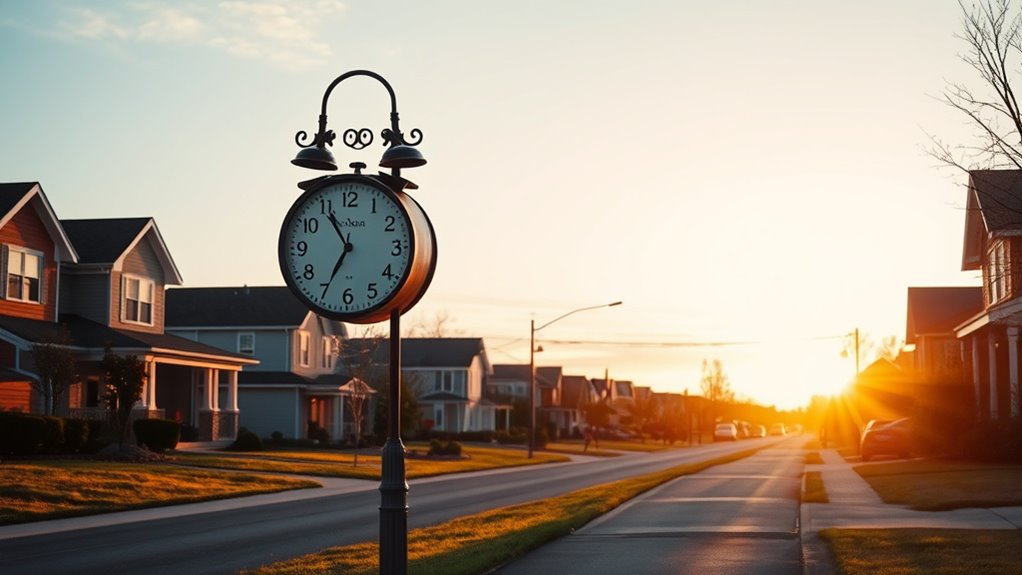Many states are rethinking daylight saving time because research shows the clock changes can harm your health, safety, and daily life. Studies link sudden shifts to increased risks of heart problems, accidents, mental health issues, and sleep loss. As concerns grow, some states want to keep a permanent standard or daylight saving time to improve well-being. If you want to learn more about what’s driving these changes and what might happen next, keep exploring this topic further.
Key Takeaways
- Rising health concerns, such as increased cardiovascular risks and sleep disruption, are prompting states to reconsider the safety of DST.
- Evidence shows that economic and energy benefits of DST are less significant than previously believed, influencing policy reevaluation.
- Some states are exploring permanent standard or daylight saving time to eliminate biannual clock changes and reduce health and safety risks.
- Variations in state policies could lead to a patchwork system, prompting calls for federal regulation to ensure consistency.
- Public health, safety, and modern lifestyle needs are driving the shift towards evidence-based decisions over traditional time changes.

As debates over the twice-yearly clock changes intensify, it’s clear that daylight saving time may no longer serve its original purpose. Many states are reconsidering whether shifting clocks forward and back truly benefits residents or if it causes more harm than good. One of the main reasons for this reevaluation centers around health impacts. When the clocks change, your body experiences a sudden disruption in sleep patterns, which can lead to increased stress, fatigue, and even higher risks of heart attacks and strokes in the days following the switch. Sleep deprivation and misaligned circadian rhythms aren’t just temporary discomforts; they can have lasting effects on your mental health, mood, and overall well-being. You might notice more accidents on the roads, a decline in productivity at work, or increased feelings of depression around daylight saving transitions. These health concerns are prompting many to question whether the clock changes are worth the potential risks, especially now that health research highlights the profound influence of sleep and natural light on your physical and mental state.
Beyond health impacts, the economic effects of daylight saving time also come under scrutiny. While proponents have long argued that longer evenings boost retail sales, outdoor activities, and tourism, recent studies challenge these claims. You may find that the supposed economic benefits don’t always materialize or are offset by costs associated with adjusting schedules, managing sleep-related health issues, or increased accidents. For example, businesses might experience disruptions as employees struggle to adapt to the time shift, leading to reduced productivity. Moreover, the energy savings once attributed to daylight saving time are now considered minimal or even negligible due to modern energy consumption patterns. States are weighing whether the economic gains justify the inconvenience and potential health costs. Some are moving toward adopting permanent standard time or permanent daylight saving time, aiming to eliminate the biannual disruption altogether, but the decision is complex. It involves balancing economic interests, public health, and the desire for more consistent daily routines.
As more states explore options to abolish or modify daylight saving time, what happens next will depend on legislative action and public opinion. You could see a patchwork of policies across the country, with some states opting out entirely or choosing to stay on one time year-round. The federal government may need to step in to establish uniform rules, but until then, your local community might be the first to test a new approach. Whatever the outcome, it’s clear that the conversation is shifting from tradition to evidence-based decision-making, prioritizing your health, safety, and daily comfort over outdated clock changes.
Frequently Asked Questions
How Does Daylight Saving Time Affect Energy Consumption?
Daylight Saving Time can impact your energy consumption by altering your daily routines. It often leads to energy savings because you use less artificial lighting in the evenings, reducing electrical demand. However, it might also increase energy use in the mornings when you need more heating or lighting. Overall, the effect on energy consumption varies, but many believe DST helps balance electrical demand and save energy during longer daylight hours.
Are There Health Risks Associated With Changing Clocks?
You might think changing clocks is harmless fun, but it actually messes with your health. The irony? Shifting time causes circadian disruption and sleep deprivation, increasing risks for heart issues, mood swings, and impaired concentration. As your body struggles to adapt, you’re unknowingly putting yourself through unnecessary stress. So, while it seems trivial, messing with your sleep cycle can have real, lasting health consequences—something to contemplate before setting your clock forward.
How Do Different States’ Opinions on DST Vary?
You’ll find that public opinion on DST varies across states, with some favoring the extra evening daylight and others preferring standard time. Legislative efforts reflect these differences, as states like California push to eliminate DST, while others resist change. Your state’s stance may depend on local preferences, health concerns, and economic factors, shaping the ongoing debate about whether to keep, modify, or abolish the time change altogether.
What Are the Economic Impacts of Abolishing DST?
Ditching daylight saving time delivers definite economic benefits. You could see significant savings on energy costs and a boost in work productivity, as consistent schedules reduce confusion and fatigue. Without the biannual clock change, businesses might streamline operations, and workers could focus more efficiently. This shift fosters financial savings and fosters a more focused, functional workforce, ultimately enhancing economic stability and growth in communities and corporations alike.
Could a Nationwide Policy Permanently End DST?
A nationwide policy that permanently ends DST could streamline farming practices and benefit the tourism industry. You’d avoid the biannual clock changes, making schedules more consistent for farmers and tourists alike. This change could reduce confusion, improve productivity, and enhance visitor experiences. While it’d require federal coordination, ending DST might create a more stable environment for both agriculture and tourism, ultimately benefiting the economy and daily routines nationwide.
Conclusion
As states reconsider daylight saving time, it’s like rewiring a tangled clock to find a smoother rhythm. You might feel the gears shifting, promising brighter days and calmer nights. Change is stirring beneath the surface, like a sunrise breaking through a cloudy sky. Whether it’s a fresh start or a gentle pause, this shift promises a future where time feels more like a trusted friend, guiding you gently through each day’s new light.
Amina brings over a decade of journalism experience to her role as Editor-in-Chief. Under her leadership, Exquisite Post has flourished, maintaining the highest standards of integrity and excellence. Amina’s commitment to truth and her visionary approach guide the editorial team in producing impactful news stories that resonate with our audience.










